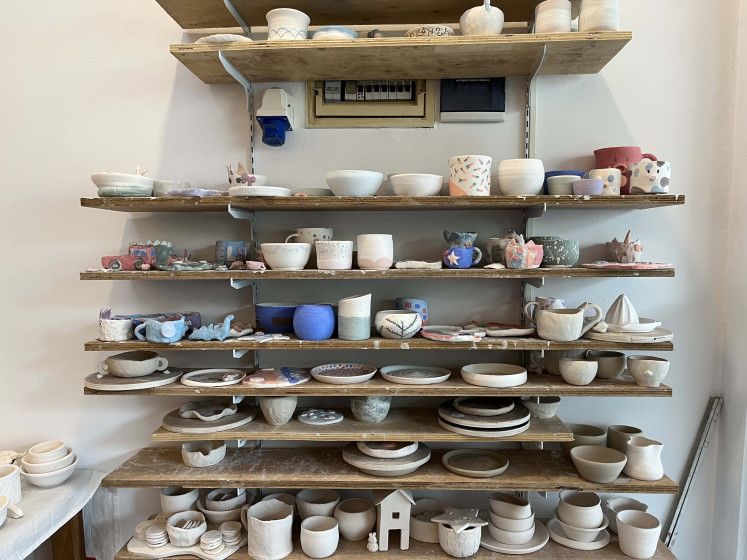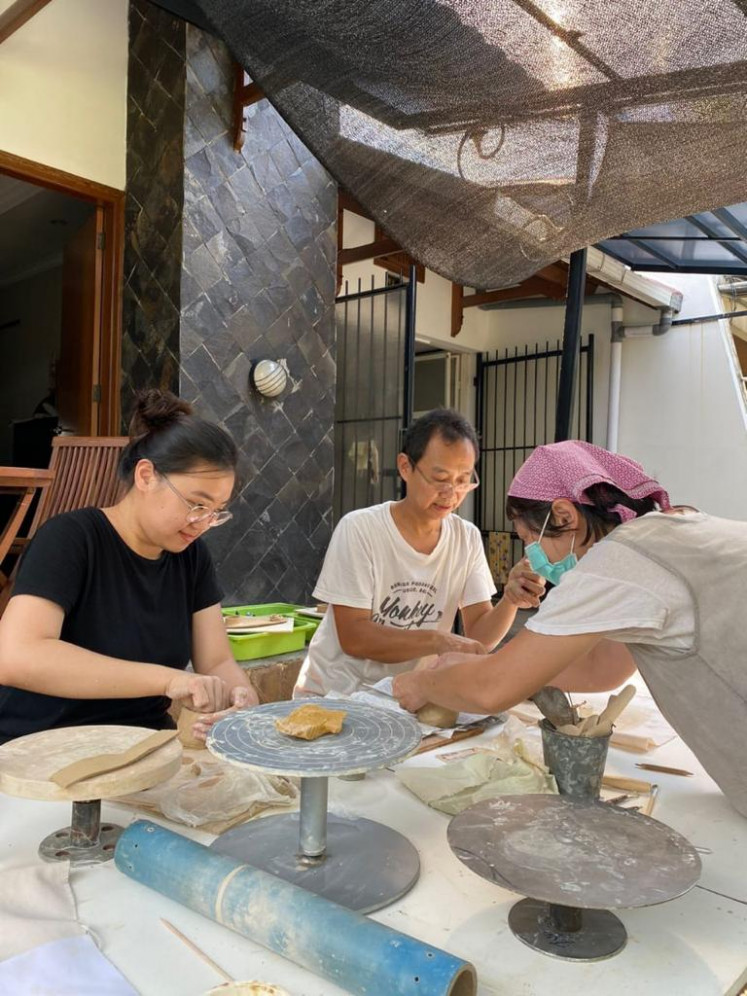Popular Reads
Top Results
Can't find what you're looking for?
View all search resultsPopular Reads
Top Results
Can't find what you're looking for?
View all search resultsIndonesia’s pottery industry finally gets its moment
After being mostly thought of as a hobby, pottery is starting to become a real commercial force in Indonesia.
Change text size
Gift Premium Articles
to Anyone
After being mostly thought of as a hobby, pottery is starting to become a real commercial force in Indonesia.
Like many hand-craft arts, pottery making relies on dexterity, employing various techniques like hand-building, pinching or coiling the clay. There are no boundaries to creating a piece; there is no right or wrong. For many Indonesians, it is an activity that lets them blow off creative and mental steam - a relaxing pastime with a tangible and satisfying result.
As the pandemic hit, the pottery industry gained steam.
For Brenda Marcel, perfecting her passion for ceramic making is a lifelong goal. An art graduate from Swinburne University, Melbourne, Brenda realized that the pandemic had pushed her to hone her pottery skills.
Brenda’s signature pottery products are cute characters inspired by Japanese animation house Studio Ghibli’s My Neighbor Totoro and the popular cartoon character SpongeBob Square Pants.
New beginning
Ivana Stacia Helmi, founder of the ceramic studio Gawe Ceramic in West Jakarta, opened her pottery studio in 2021. Ivana started her pottery business right after she was laid off from her previous work. Pivoting to a career in pottery had never crossed her mind, but she had no other choice.
“It was my dream to have my own studio for my retirement days. But I never thought I would have to retire at such a young age,” Ivana said.
Luckily, during her university years as a product design student, Ivana had the chance to explore different materials including clay. There, her teachers gave her the creative freedom to explore. She also took an apprenticeship at Jenggala Art Studio in Bali back in 2010. Her father encouraged her to open up a small studio in their garage at home in Puri Indah, West Jakarta.
Ivana started her workshops only for her close friends and neighbors. But news about her pottery studio spread quickly among her circles, as participants shared online the joy they found in making pottery. Currently, the garage is filled up with the projects made by her students, who range from 10-year-olds to those in their mid-twenties.
“Initially, I thought nobody would be interested in being my student, so I started some pottery lessons on my own YouTube channel. It turned out I received positive feedback,” Ivana continued. Ever since Ivana opened her studio in October 2021, she has taught over 239 students, something she finds far more fulfilling than her nine-to-five job.
Cecilia Margono is one of Ivana’s regular customers and students. As a newlywed, Cecilia wanted to decorate her house with artwork that reflects her taste and personality. “It was relaxing, and when you fail your technique, you have the urge to do it better,” Cecilia shared. For now, she is looking forward to moving into her house where she can finally exhibit her ceramic pieces.
Industry changes
Nasrullah, who sells pottery supplies, said that his customers have doubled ever since the pandemic started. “I have at least 650 customers now. I think pottery as a hobby isn’t as niche as it used to be,” he added. Nasrullah’s pottery class enrollment fees start from Rp 145,000 ($ 9.70). Thanks to the presence of social media, hashtags such as #potteryjakarta, #ceramicindonesia and #potteryjakarta allow people to easily find workshop places.
Haryoadiputro Soenggono is the owner of Bengkel Keramik Puspa 5. Being a studio with a longer pottery workshop duration, he keeps his class small by allowing only 20 students for each session.
For over twenty years Haryoadiputro has witnessed how the industry has changed. Prior to opening his workshops, he took an apprenticeship with Liem Kieng Seng, a local grandmaster potter of his time in 1998. “Back when I started my apprenticeship, there weren’t many studios available. These day workshops focus only on the basics. But it’s a positive thing because it brings the business from the brink of extinction,” he shared.
Haryoadiputro said that classes he took lasted up to 2.5 years before he was able to master most techniques. Master Liem would teach Haryoadiputro the basic skills like throwing and trimming the clay before he could get his hands on creating eclectic pieces. “I think it’s worth it because you could create something usable out of the soil,” he said. Haryoadiputro has also birthed some of Jakarta’s local artists, like Stanley Wangsadihardja.
Ardhana Riswarie, a registered art psychotherapist with The Australian, New Zealand and Asian Creative Arts Therapies Association (ANZACATA), shared that she was not surprised by the trend. Throughout the pandemic, people were looking for more activities that could help them regulate and express themselves.
“The process of creating pottery or other forms of art also reflects how eventually we need to accept ourselves,” Ardhana said. She further added that manipulating malleable clay is quite meditative without people realizing it.
Perfection in imperfection: Stanley Wangsadihardja and his wife, Susy Gunawan, mostly use pinching techniques and naturally made glaze. (Courtesy of Stanley Wangsadihardja) (Courtesy of Stanley Wangsadihardja/Courtesy of Stanley Wangsadihardja)Self-acceptance
As an architect, the world of art is nothing new to Stanley. As coowner of Rupa Pottery alongside his wife, Susy Gunawan, he focused on the pinching and hand-building techniques with the hope that his students would embrace the flaws in each piece. The style allows potters to produce diverse and unique forms.
In addition to the hand-building technique, Stanley also focuses on the rustic style. To create an earthy tone, Stanley utilizes natural dyes like leaves for his ceramic glaze. “I appreciate how everything unexpectedly shows its charms. When you see a crack on the finished product, I see it as our strength,” Stanley said. Usually, Stanley creates usable art pieces, such as mugs, incense holders and paint palettes.
“The process teaches you that even if the outcomes sometimes are not the way you expect them to be, you will learn to appreciate and accept them the way they are,” he added. Stanley further explained that the likelihood of a batch of pottery being botched is 30 percent, thus teaching everyone that failing is alright. It also teaches the potter to have patience, as the firing of the piece can take up to two to three weeks.
Stanley predicted that in the future the pottery industry would continue to grow, especially since there are social media platforms that help promote the pottery communities in Indonesia. He further added that the pottery world was also a tight-knit community where people could learn new skills and showcase their pieces together.
But there is more than that; Stanley hopes that every artist who has started their business would not stop, and continues to learn new techniques.
“Commitment is necessary to pursue pottery because you need to enjoy the process, the beauty and the failures.”












